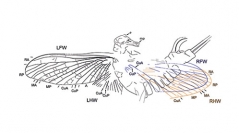

 Comptes Rendus Palevol
14 (5) - Pages 346-352
Comptes Rendus Palevol
14 (5) - Pages 346-352Fossil insects of the Late Carboniferous have been popularized as lost giants of the past. However, their small contemporaries are very poorly known. In this paper, we report the discovery of the smallest known member of the Palaeodictyoptera, an extinct group of sap-feeders including some of the largest insects ever known. The new representative, Tytthospilaptera wangae, collected at the Xiaheyan locality (Ningxia, China; early Late Carboniferous), belongs to the Spilapteridae and had a wing span of only about 2 cm. Observed veins elevation is best explained by a simple (convex) MA with a (concave) branch of MP translocated onto it. This pattern is congruent with the one involving a series of ‘simple anterior sectors and branched posterior sectors’, observed in many Palaeodictyoptera families. We compiled size data on the corresponding superfamily (viz., the Spilapteroidea). The available sample is found insufficient to adequately test the hypothesis of a global effect of an elevated atmospheric
Spilapteridae, Namurian, Size distribution